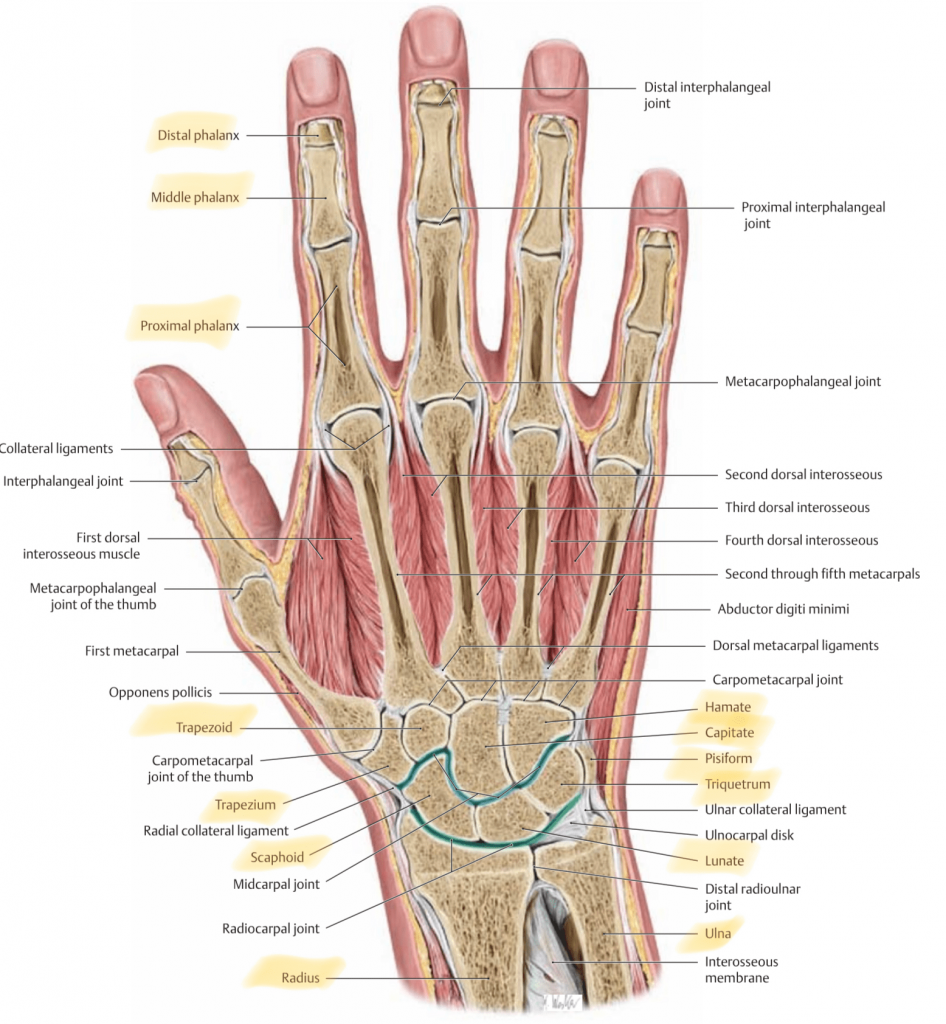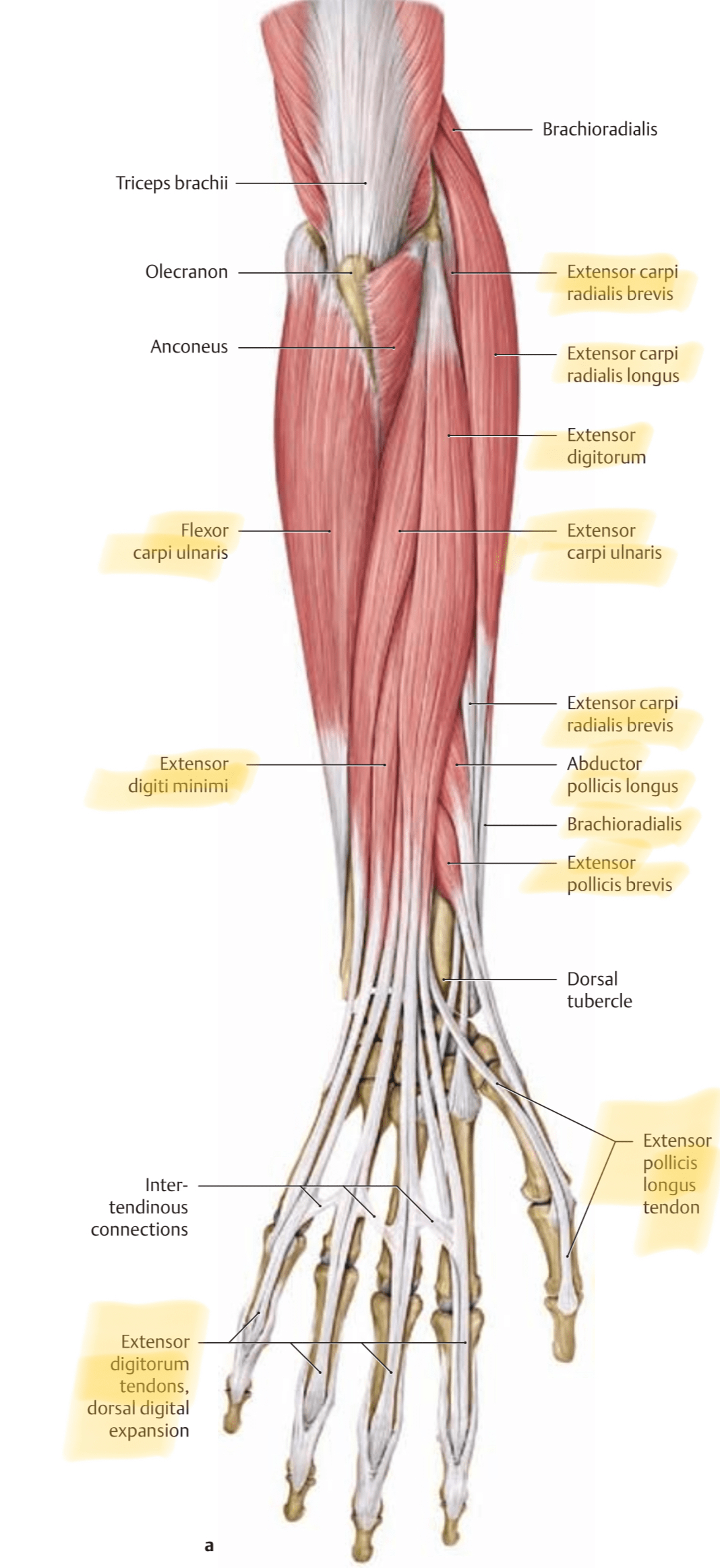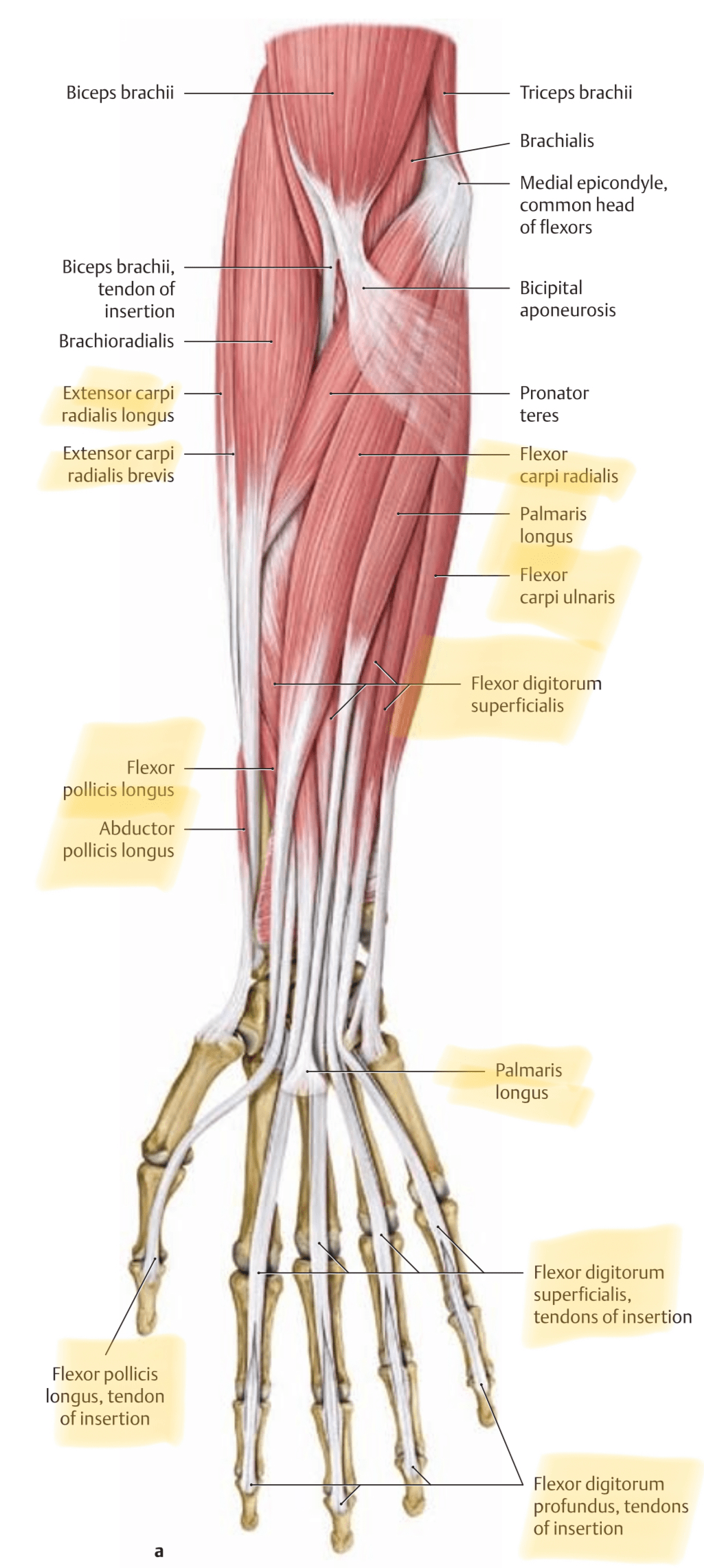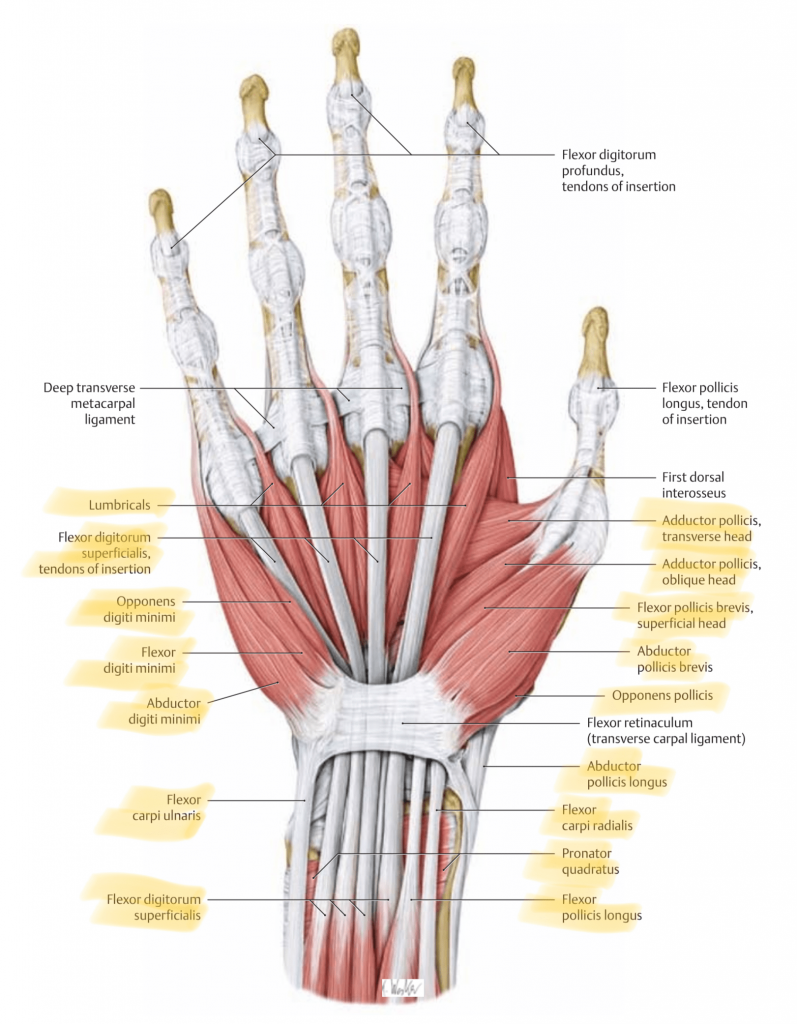The best number of repetitions for hand exercises depends on your goals and your current fitness levels. For regular strength training between this would be 8 and 50 repetitions can be beneficial where functional climbing-specific hand exercises the number of repetitions should be adapted to your climbing goals.
This blog is the third in a series that discusses the best number of repetitions for 3 different joints. If you’ve read the blog about the elbow, you’ll find plenty of similarities in this article because the elbow and the hand are very closely connected.
In this blog too, I start with the anatomy of the wrist and hand whereafter I discuss the muscles of the area. I then finish with the best number of repetitions for hand exercise, both in the case of injury and normal function.
Let’s dive right in!
1. Wrist and Hand Anatomy
The wrist and hand are made up of 15 bones. They interconnect through a variety of joints. And where most bones in the body connect to one bone at the back, and another at the front, in the hand this is different.

The radius, for example, connects to the ulna, the scaphoid, and the lunate bone. The latter are 2 of the 8 carpal bones of the hand. These tiny bones allow for plenty of movement within the hand palm and their mobility is thus essential for you to use your hand freely.
In the martial arts community, you’ll find athletes that have broken their hand once or more and that have difficulty moving in this area. You’ll notice this by the fact that they can bend their wrist and fingers but less so the part in between. A restriction in the moving joints is also common. Because all the joints are all so closely connected through joints, connective tissue, muscles, and ligaments that when one area is injured the area around is easily affected too. As things go, all joints work together to give you your movement freedom. But there’s little room for compensation.
I became aware of the complexity of movement in the hand through an interesting observation: how a former cage fighter was itching his nose. With limited mobility in the wrist and the carpal joints, it looks silly and hard. Give it a try yourself. Itch your nose while you allow yourself to barely move your wrist and use your fingers normally.
Did you notice how you must compensate for your elbow and shoulder? This shows how connected the kinetic chain from the spine and shoulder to the hand and fingers is.
The anatomy of the hand is complex for a reason. It provides plenty of movement liberty to manipulate objects or climb holds. But if movement is somehow restricted in this tiny area you notice this up the entire kinetic chain.
And since it’s a tiny area there’s also a heightened chance for nerve entrapment. Which on the hand comes in the form of carpal tunnel syndrome. This is an irritation of the median nerve in the carpal tunnel which in most cases can be treated conservatively and sometimes requires carpal tunnel release surgery.
2. Which Muscles Belong to the Hand?
26 muscles are crossing the wrist and hand. Here’s a list of all of them. And to be honest, even I was surprised to see there are 27 muscles in the hand. I never counted them, and the interossei and lumbricals are muscle groups, so there are actually around 36 muscles in the hand.
There’s no reason you should know these muscles by heart, just have a look at them when you injure one. Because if you know the exact function of the muscle, you’ll know how to load it specifically and in isolation. And besides, seeing all the muscles, next to the high number of bones and joints in the hand, will give you a complete perspective on the complexity of the region.
Muscles originating around the elbow:
- Flexor digitorum superficialis: bends wrist and fingers
- Flexor carpi radialis: bends and radially deviates wrist
- Flexor carpi ulnaris: bends and deviates wrist to ulnar
- Palmaris longus: tenses palmar aponeurosis (connective tissue plate)
- Extensor carpi radialis longus: extends and radially deviates the wrist
- Extensor carpi radialis brevis: extends and radially deviates the wrist
- Extensor digitorum: extends the fingers and wrist
- Extensor digiti minimi: extends and ulnar deviates the wrist, extends the pinky finger
- Extensor carpi ulnaris: extends and deviates the wrist to ulnar


Wrist Muscles originating in the forearm:
- Flexor digitorum profundus: bends wrist and fingers
- Flexor pollicis longus: bends and radially deviates the wrist and bends the thumb
- Pronator quadratus: pronates the wrist
- Abductor pollicis longus: radially deviates the wrist and abducts the thumb
- Extensor pollicis brevis: extends and radially deviates the wrist, extends the thumb
- Extensor pollicis longus: extends and radially deviates the wrist, extends the thumb
- Extensor indicis: extends the wrist and the index finger
Intrinsic Hand Muscles:
- Abductor pollicis brevis: abducts the thumb
- Adductor pollicis: adducts the thumb
- Flexor pollicis brevis: bends the thumb
- Opponens pollicis: puts the thumb opposite the other finger (we’re the only animal who can do this)
- Abductor digit minimi: abducts the pinky finger
- Flexor digiti minimi: bends the pinky finger
- Opponens digiti minimi: puts the pinky finger opposite the hand palm
- Palmaris brevis: tenses the palmar fascia
- Lumbricales: bends the joint between the mid-hand and the finger while extending both the finger joints of the 2 to 5th fingers.
- Dorsal Interossei: bends the joint between the mid-hand and the finger of the 2nd to 4th while also making an extension and abduction of the other joints in the same fingers
- Palmar Interossei: bends the joint between the mid-hand and the finger of the 2nd, 4th and 5th finger while also making in an extension and adduction of the other joints in the same fingers

3. How Many Repetitions Should You Do for Your Hand Exercises?
Before I tell you exactly which rep-ranges are best for your wrist and hand, it’s important to make a distinction between a healthy wrist and hand and an injured one. And between regular strength training and climbing-specific training.
Specific strength training for the wrist is like that for the elbow since a lot of muscles that cross the wrist originate in the elbow area.
Let’s start with the healthy hand and wrist (if you’ve read the blog about how many repetitions you should do for elbow exercises, this part is the same).
For regular strength training:
- Flexion and extension-based exercises you can train all rep-ranges. From endurance, 30-50 repetitions, to hypertrophy, 8-12 repetitions, to maximum strength 4-6 repetitions.
- For all the exercises which involve the elbow and the wrist and thus smaller muscles, I don’t see any point in training below 8-12 repetitions for hypertrophy. If you want to develop max strength in these muscles, which is important for climbing, it’s best to do so with climbing-specific exercises.
For climbing-specific exercises:
- Hang board: train endurance with repeaters doing for example 3 rounds of 5x7second hangs with a 3-second break between repeats and 3-5 minute breaks between sets. Or train max strength anywhere from 5-15 seconds with 3-5 minute breaks between hangs.
- Campus board: for absolute power 1-3 moves with at least 5-minute breaks between sets. Or power endurance by doing up to 10 moves, with at least 5-minute breaks between sets.
- On the wall: for max strength 3-5×3-6 hard moves close to or at your limit with 3-5 minute rest between sets. For endurance do 30-50 moves continuously on different boulder problems or on a regular sport route without resting on good holds.
And finally, let’s see how many repetitions you can use to train an injured elbow.
But obviously, not before you know exactly which structure is injured. If it’s a muscle, have a look at the list of muscles and movements above so that you know exactly how to load it. If it’s another structure, you might need to wait more or less time until you can start training. In any case, you should talk to a professional to get a tailored rehab plan.
Still, here are some general recommendations. First for regular strength training:
- Start with low intensity, while doing 3×20-30 repetitions staying far away from failure
- Then move down in steps of 5 repetitions while you increase the resistance each time you can do the previous rep-range without any irritation after the exercise (light pain allowed but subsides right after you stop the exercise)
For climbing-specific training:
- Submaximal hangs at 10%, then 20%, then 30% of your max intensity. Increase according to the no-irritation rule I mentioned above. Do 10x10seconds with 50-second breaks.
- When this is easy move onto 3x10second hangs with 3-minute rests with a little discomfort at the injury site.
- Then move onto a regular hang board protocol
If you want to know how much rest and which intensity is best for each repetition range read my blog about strength training for rock climbing. And read the article about the periodization of strength training to get a better idea of how to plan your training plan.
The bottom line is that the hand is an insanely complex area to train when you look at it closely. However, when it’s not injured you should train it functionally with climbing-specific exercises whenever you can. In case of injury, talk to a professional to discuss the best way to heal it.
